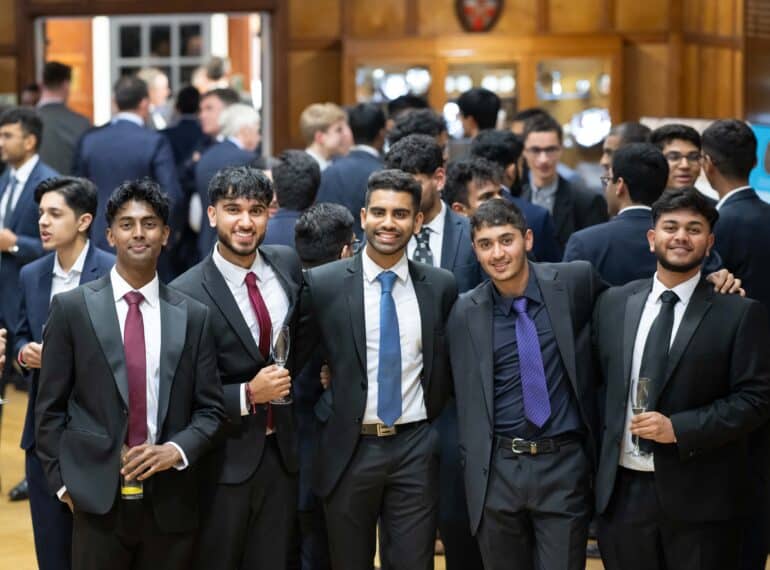
Guests at this year’s QE alumni dinner enjoyed a new, more relaxed approach to the occasion, while also making the most of a few additional activities during the evening.
Always a highlight of the Autumn Term, the dinner gained additional importance this year since it came in the School’s 450th anniversary year. One hundred and fifteen diners – a record attendance in recent years – gathered at Queen’s Road.
They were overlooked – but hopefully not put off their sumptuous fare! – by portraits of the two key figures in the School’s 1573 founding, Queen Elizabeth I and Robert Dudley, Earl of Leicester, in the Dining Hall.
The guests ranged widely in age, from those who were pupils in the 1950s to a group of 31 who all left the School in 2020 during the first year of the Covid pandemic.
Headmaster Neil Enright said: “The OE dinner is a great reminder and celebration of the strength of our Elizabethan community.
“While our guests certainly seemed to appreciate the extra attractions we laid on for them to enjoy in our anniversary year, the dinner is mainly about people spending time with friends, making new connections and remembering their time at QE. And in this, it was a great success, with a lovely atmosphere, excellent food and some really positive feedback afterwards.”
The evening began with the QE Saxophone Ensemble playing in the Main School Hall while guests enjoyed welcome drinks. Their tunes included Irving Berlin’s 1929 song, Puttin’ on the Ritz, its title a reference to a slang expression of the time meaning to dress conspicuously and fashionably. With the black-tie dress code of previous years relaxed for this year’s new-style dinner, there was plenty of opportunity for guests to do just that: colourful ties were there in abundance (although, in fact, even ties were not compulsory).
Guests had the opportunity before and after dinner to look through materials from the School’s archives. There were also tours of the Mayes and Main buildings, with current Sixth Form students Danylo Gutsulyak, Maxwell Johnson and Sena Lai-Fujiwara all playing the piano in the Friends’ Recital Hall, entertaining the visitors and amply demonstrating the acoustics in this major new facility opened in May 2022.
Personal messages written by the Headmaster on specially produced postcards were provided for each guest.
In his words of welcome, Mr Enright recapped on the anniversary year, including the launch on 1st March of former Headmaster John Marincowitz’s “excellent” new history of the School, Queen Elizabeth’s School: 1573–2023. “It is never too early for some QE-themed Christmas shopping!” he said.
While some of the formalities involved in previous years’ dinners were dispensed with, the evening still featured the presentation of the Eric Shearly Memorial Prize awarded to 2023 School Captain Darren Lee by Martyn Bradish, Chairman of the Old Elizabethans Association.
Also retained were the traditional toasts. Eric Houston – President of the association, Master 1976–2010, and Second Master 1999–2010 – duly toasted: His Majesty The King; The pious memory of Queen Elizabeth I, our founder; Friends, present and absent; and The School.
The dinner included confit lamb shoulder croquettes and roasted chicken breast (with cauliflower bhaji and autumnal vegetable pithivier as vegetarian options), followed by dark chocolate torte and then tea or coffee, served with homemade petit fours.
- Click on the thumbnails below to view a selection of photos. (QE alumni can see all the images from the evening on QE Connect.)

 The 44-page publication features 26 pieces of poetry, prose, and art, many of them inspired by its anniversary-related theme, How did we get here? The approach, looking both backward and forward, mirrors that of the School’s anniversary celebrations on Founder’s Day which included a display of the School’s 1573 Royal Charter alongside the burying of a time capsule intended for the pupils of 2073, when QE will mark its 500th anniversary. Work on the magazine began last academic year, but it has only now been published.
The 44-page publication features 26 pieces of poetry, prose, and art, many of them inspired by its anniversary-related theme, How did we get here? The approach, looking both backward and forward, mirrors that of the School’s anniversary celebrations on Founder’s Day which included a display of the School’s 1573 Royal Charter alongside the burying of a time capsule intended for the pupils of 2073, when QE will mark its 500th anniversary. Work on the magazine began last academic year, but it has only now been published. The poetry section is highly varied, with contributions ranging from Year 9 boy Yingqiao Zhao’s piece about the moon – which is in the shape of a crescent and has key words picked out in different colours – to the nine-stanza rhyming French poem, La Mort de L’Ancien, composed by Year 13’s Aayush Backory. The poetry section closes with Nikhil Francine, of Year 9, addressing the anniversary directly with a poem entitled Thriving from Ancient Roots – the School’s slogan for the anniversary year.
The poetry section is highly varied, with contributions ranging from Year 9 boy Yingqiao Zhao’s piece about the moon – which is in the shape of a crescent and has key words picked out in different colours – to the nine-stanza rhyming French poem, La Mort de L’Ancien, composed by Year 13’s Aayush Backory. The poetry section closes with Nikhil Francine, of Year 9, addressing the anniversary directly with a poem entitled Thriving from Ancient Roots – the School’s slogan for the anniversary year.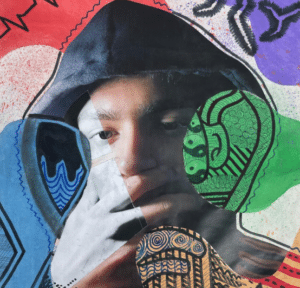 Interspersed throughout The Arabella are artworks exploring themes including Expressive Heads, Distortion and Identity; Dystopian Landscape; and Art Inspired by Music. Shown in this news story, from top to bottom, are:
Interspersed throughout The Arabella are artworks exploring themes including Expressive Heads, Distortion and Identity; Dystopian Landscape; and Art Inspired by Music. Shown in this news story, from top to bottom, are: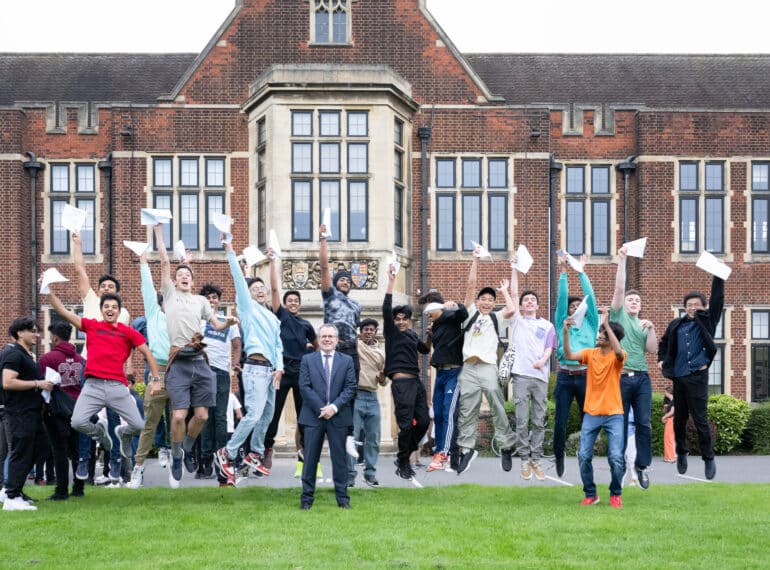
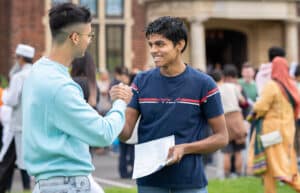 At the highest possible grade, the School improved significantly on its 2019 figures, with 58.2% of A-levels being awarded A* – easily beating the pre-pandemic record of 46.9% set in 2018. It was a similar record-breaking performance for combined A–A*: 89.1% of A-levels had these grades, well above the equivalent figure in the pre-Covid years.
At the highest possible grade, the School improved significantly on its 2019 figures, with 58.2% of A-levels being awarded A* – easily beating the pre-pandemic record of 46.9% set in 2018. It was a similar record-breaking performance for combined A–A*: 89.1% of A-levels had these grades, well above the equivalent figure in the pre-Covid years.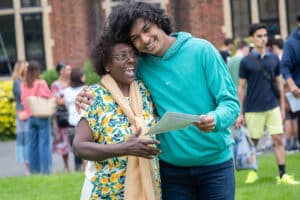 “We recognise that this Year 13 cohort has not always had an easy journey: they were unable to sit their GCSEs because of Covid, so, like their peers across the country, this was the first time they had faced high-stakes testing.
“We recognise that this Year 13 cohort has not always had an easy journey: they were unable to sit their GCSEs because of Covid, so, like their peers across the country, this was the first time they had faced high-stakes testing. Among many successes across the subjects this year, French stands out for its 100% performance – all five candidates achieved A*.
Among many successes across the subjects this year, French stands out for its 100% performance – all five candidates achieved A*.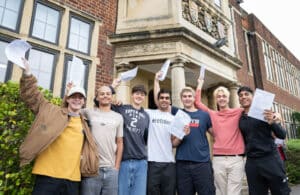 “They should be proud of the wider contribution they have made. Known for their kindness and empathy, they have supported each other as friends, and those lower in the School as peer mentors. They have also helped to establish and develop connections with the local Barnet community, such as our QE Together partnership with Queen Elizabeth’s Girls’ School.”
“They should be proud of the wider contribution they have made. Known for their kindness and empathy, they have supported each other as friends, and those lower in the School as peer mentors. They have also helped to establish and develop connections with the local Barnet community, such as our QE Together partnership with Queen Elizabeth’s Girls’ School.”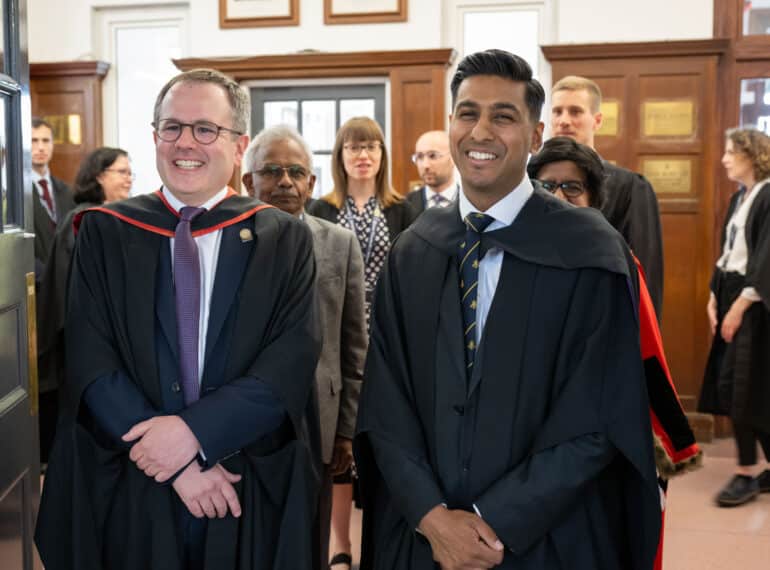
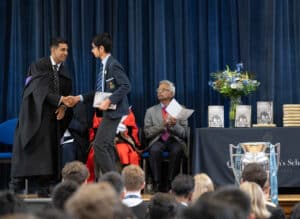 Former QE First XI cricket captain and First XV rugby player Sunil Tailor (OE 1996–2006) was the guest of honour, telling the boys that he had now united his love for sport with his career in accountancy: he is the Head of Commercial Finance at reigning Premiership champions Saracens.
Former QE First XI cricket captain and First XV rugby player Sunil Tailor (OE 1996–2006) was the guest of honour, telling the boys that he had now united his love for sport with his career in accountancy: he is the Head of Commercial Finance at reigning Premiership champions Saracens. Sunil read Economics at UCL, graduating in 2009, and was a cricket coach at Middlesex from 2007–2011. He worked for more than ten years for accountancy firm MHA MacIntyre Hudson before joining Saracens in November 2022.
Sunil read Economics at UCL, graduating in 2009, and was a cricket coach at Middlesex from 2007–2011. He worked for more than ten years for accountancy firm MHA MacIntyre Hudson before joining Saracens in November 2022.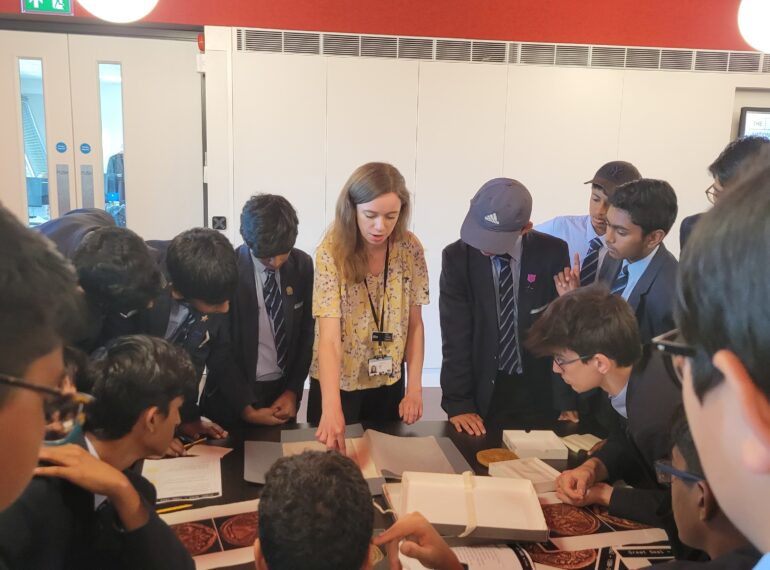
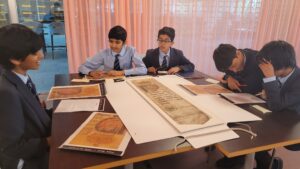 Among the artefacts viewed by the group during their visit to Kew was the actual letter – known as the ‘Tide Letter’ – written by the future Queen Elizabeth I, founder of Queen Elizabeth’s School, as she battled for survival following her arrest in 1554.
Among the artefacts viewed by the group during their visit to Kew was the actual letter – known as the ‘Tide Letter’ – written by the future Queen Elizabeth I, founder of Queen Elizabeth’s School, as she battled for survival following her arrest in 1554.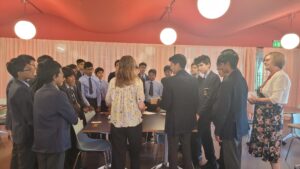 The visit was a reward for the boys who submitted the best entries to Project 1573. This involved small groups of boys being given three primary sources relating to a particular aspect of QE’s history and then asked to produce a three-minute presentation after accessing
The visit was a reward for the boys who submitted the best entries to Project 1573. This involved small groups of boys being given three primary sources relating to a particular aspect of QE’s history and then asked to produce a three-minute presentation after accessing 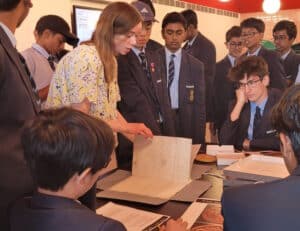 Kelvin Chen, Ethan Yao, Jonas Dawit and Rishi Sen, also of Year 8 Pearce, researching E W Harrison, a long-serving teacher who retired in 1950 and is one of the two unrelated people after whom the Harrisons’ House is named
Kelvin Chen, Ethan Yao, Jonas Dawit and Rishi Sen, also of Year 8 Pearce, researching E W Harrison, a long-serving teacher who retired in 1950 and is one of the two unrelated people after whom the Harrisons’ House is named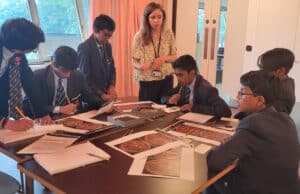 “The students were able to see the neat handwriting at the start of the letter become larger and messier as she was likely made to hurry by those waiting to escort her to the Tower. Fearing her enemies might alter the letter, Elizabeth struck lines through the blank space above her signature,” said Mrs Blackford.
“The students were able to see the neat handwriting at the start of the letter become larger and messier as she was likely made to hurry by those waiting to escort her to the Tower. Fearing her enemies might alter the letter, Elizabeth struck lines through the blank space above her signature,” said Mrs Blackford.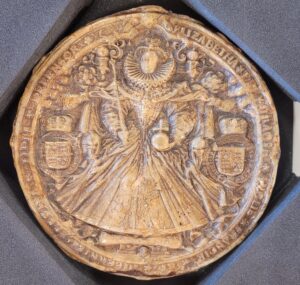 QE’s founding Royal Charter of 1573 was authorised with Queen Elizabeth’s first seal. This, however, wore out during her long reign, and, Ms Blackford said, the boys enjoyed finding out about its replacement: “It is noticeably more elaborate, as Elizabeth had started to closely monitor her image.”
QE’s founding Royal Charter of 1573 was authorised with Queen Elizabeth’s first seal. This, however, wore out during her long reign, and, Ms Blackford said, the boys enjoyed finding out about its replacement: “It is noticeably more elaborate, as Elizabeth had started to closely monitor her image.”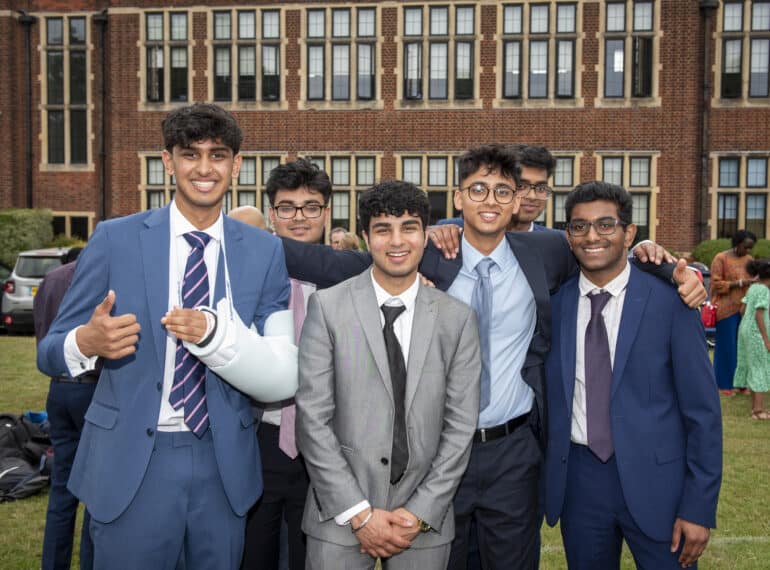
 There were prizes for some, while the contribution of all the leavers – or graduands – was celebrated during an occasion in Shearly Hall that featured speeches and presentations, followed by afternoon tea on Staplyton Field.
There were prizes for some, while the contribution of all the leavers – or graduands – was celebrated during an occasion in Shearly Hall that featured speeches and presentations, followed by afternoon tea on Staplyton Field. Headmaster Neil Enright thanked parents for their “huge support, both moral and financial, over the years” and urged both them and their sons to stay in touch with the School.
Headmaster Neil Enright thanked parents for their “huge support, both moral and financial, over the years” and urged both them and their sons to stay in touch with the School. Sahil attended Valediction together with his mother, cousin, friends and his brother, Nikhil Handa (OE 2013–2020). He recalled his first encounter with Deputy Head (Pastoral) David Ryan, who hauled him over the coals after spotting him dancing outside the classroom window to entertain his classmates during afternoon form time. This less-than-auspicious beginning soon turned into a supportive relationship, however, when he became part of Mr Ryan’s English class. “I thought he’d make my life miserable. But to my surprise, it seemed as though he’d forgotten the whole episode entirely. I went on to learn everything from him… Mr Ryan was also the first person who complimented me for being a generalist.”
Sahil attended Valediction together with his mother, cousin, friends and his brother, Nikhil Handa (OE 2013–2020). He recalled his first encounter with Deputy Head (Pastoral) David Ryan, who hauled him over the coals after spotting him dancing outside the classroom window to entertain his classmates during afternoon form time. This less-than-auspicious beginning soon turned into a supportive relationship, however, when he became part of Mr Ryan’s English class. “I thought he’d make my life miserable. But to my surprise, it seemed as though he’d forgotten the whole episode entirely. I went on to learn everything from him… Mr Ryan was also the first person who complimented me for being a generalist.” A large majority of Year 13 students attended. All received a set of QE cufflinks, while the prizewinners also received a copy of former Headmaster Dr John Marincowitz’s new history of the School, Queen Elizabeth’s School: 1573–2023. Among the speakers was Theo Mama-Kahn, School Captain 2022, who was one of the leavers. He gave a vote of thanks.
A large majority of Year 13 students attended. All received a set of QE cufflinks, while the prizewinners also received a copy of former Headmaster Dr John Marincowitz’s new history of the School, Queen Elizabeth’s School: 1573–2023. Among the speakers was Theo Mama-Kahn, School Captain 2022, who was one of the leavers. He gave a vote of thanks.